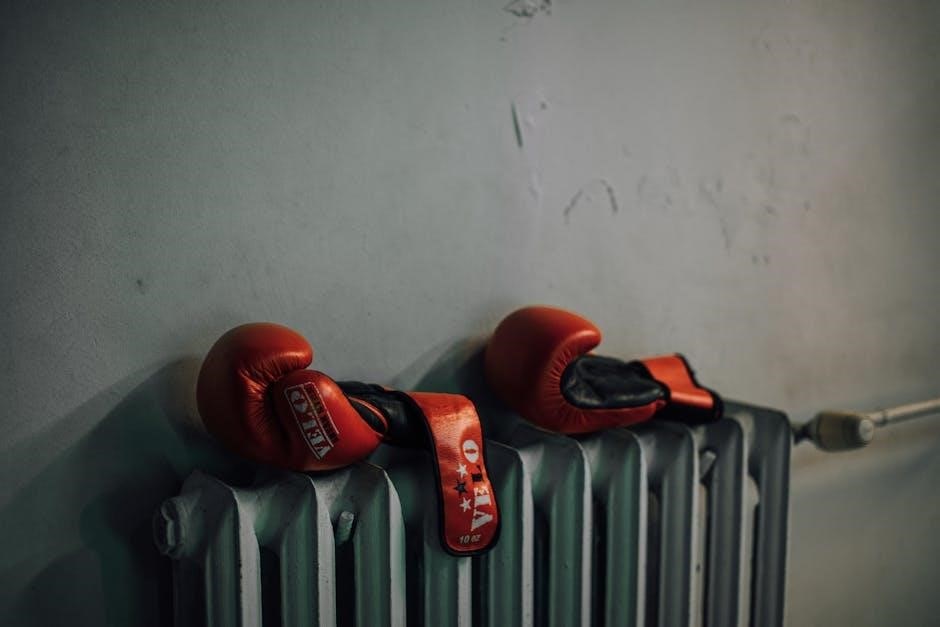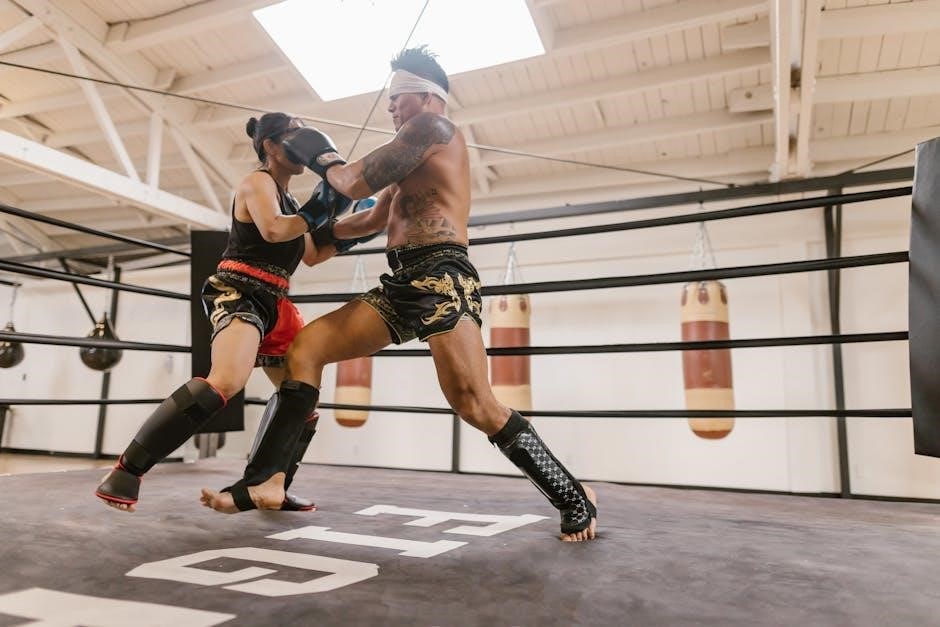Choosing the right boxing gloves size is crucial for performance‚ safety‚ and comfort. This guide helps you understand glove sizes‚ weights‚ and fitting tips to ensure optimal protection and training efficiency.
Importance of Choosing the Right Size
Choosing the right size of boxing gloves is essential for both safety and performance. Ill-fitting gloves can lead to hand injuries‚ poor technique‚ and discomfort during training or competition. Properly sized gloves provide adequate protection for your hands while striking‚ ensuring better shock absorption and reducing the risk of injury. They also allow for a firm grip‚ enhancing control and precision in your punches. Additionally‚ the right size ensures optimal comfort‚ enabling you to train longer without fatigue or discomfort. Whether you’re a beginner or an advanced boxer‚ selecting gloves that match your hand size and training needs is crucial for peak performance and long-term success in the sport.
Overview of Boxing Glove Sizes and Weights
Boxing gloves are available in various sizes‚ typically ranging from 6 to 24 ounces‚ with common sizes being 10oz‚ 12oz‚ 14oz‚ and 16oz. The weight of the gloves corresponds to the amount of padding‚ with heavier gloves offering more protection. Lighter gloves‚ such as 8-10oz‚ are often used by younger boxers or for light training‚ while 12-14oz gloves are ideal for general training and bag work. Heavier gloves‚ like 16-18oz‚ are preferred for sparring as they provide greater hand and face protection; The size is determined by both the boxer’s weight and hand circumference‚ ensuring a snug yet comfortable fit. Understanding these size and weight options helps in selecting the appropriate gloves for specific training purposes and skill levels.

How Boxing Gloves Are Sized
Boxing gloves are sized by weight in ounces and hand circumference‚ ensuring a proper fit for training‚ sparring‚ and competitions while providing adequate protection and comfort.
Measurement by Weight in Ounces
Boxing gloves are commonly sized by their weight in ounces‚ ranging from 6 oz to 24 oz‚ with 12 oz‚ 14 oz‚ and 16 oz being the most popular for training and sparring. Lighter gloves (8-10 oz) are ideal for smaller boxers or youths‚ while heavier gloves (16-18 oz) provide more padding for sparring and heavier boxers. The weight reflects the amount of padding‚ with heavier gloves offering greater protection for both hands and opponents. The right weight depends on your weight‚ skill level‚ and training purpose. For example‚ 10 oz gloves are often used in professional competitions‚ while 14 oz gloves are preferred for sparring due to their balanced protection and impact absorption. Always consider your training goals and partner safety when selecting glove weight.
Hand Circumference Measurement
Measuring your hand circumference is a key factor in selecting the right boxing gloves. To do this‚ wrap a flexible tape measure around your dominant hand‚ just below the knuckles‚ with your fingers together. This measurement helps determine the optimal fit‚ ensuring the gloves stay secure during training. Generally‚ smaller hands (5-6 inches) suit lighter gloves (10-12 oz)‚ while larger hands (7-8 inches) require heavier gloves (14-16 oz) for better protection. However‚ hand size alone isn’t enough; consider your weight and training type as well. Always refer to a size chart for accurate sizing‚ as different brands may vary slightly. Proper fit ensures comfort and prevents injuries‚ so take the time to measure carefully and try on gloves if possible.
Boxing Glove Size Charts
Size charts simplify glove selection by categorizing sizes based on weight and hand circumference. They guide you to the perfect fit for training‚ sparring‚ or competition‚ ensuring safety and performance.
Size Chart Based on Weight Categories
A size chart based on weight categories helps boxers choose gloves according to their body weight. For instance‚ boxers under 100 lbs typically use 6-8 oz gloves‚ while those between 100-125 lbs opt for 10-12 oz. Heavier boxers‚ 151-175 lbs‚ prefer 14 oz gloves for sparring. Over 175 lbs‚ 16 oz gloves are recommended for heavy sparring. This chart ensures proper protection and balance‚ preventing injury and enhancing performance. By aligning glove weight with body weight‚ boxers can train safely and effectively‚ whether for bag work or competitive matches.
Size Chart Based on Hand Measurement
A size chart based on hand measurement is another reliable method for selecting boxing gloves. Measure the circumference of your dominant hand just below the knuckles. For smaller hands (5-6 inches)‚ 6-8 oz gloves are ideal‚ while medium hands (6-7 inches) suit 10-12 oz gloves. Larger hands (7-8 inches) typically require 14-16 oz gloves. This method ensures a snug‚ comfortable fit‚ preventing excessive movement that could lead to injury. Proper hand measurement aligns with glove size to provide adequate padding and support. Always refer to brand-specific charts‚ as sizes may vary slightly between manufacturers. This approach guarantees optimal protection and performance for training or competition.

Choosing the Right Glove Size for Different Purposes
Choosing the right glove size depends on your training purpose. For training and bag work‚ 12-14 oz gloves are ideal. Sparring requires 16-18 oz for better protection. In competitions‚ sizes vary by weight class‚ with lighter boxers using 10 oz and heavier ones opting for 12 oz gloves.
Gloves for Training and Bag Work
For training and bag work‚ 12-14 oz boxing gloves are highly recommended. These weights provide adequate padding to protect your hands during repetitive strikes‚ while allowing for a full range of motion. Lighter boxers (under 150 lbs) often prefer 12 oz gloves‚ as they are lighter and easier to maneuver. Heavier boxers or those who need extra cushioning may opt for 14 oz gloves. Proper fit is essential to prevent hand fatigue and injury. Ensure the gloves are snug but not too tight‚ allowing for a firm grip and comfortable movement. This size range is ideal for general training‚ as it balances protection and responsiveness‚ making it suitable for both beginners and experienced boxers alike.
Gloves for Sparring
When it comes to sparring‚ 16-18 oz boxing gloves are the standard choice. These heavier gloves offer more padding‚ providing better protection for both you and your partner. The additional weight ensures reduced impact on the opponent‚ making them safer for live drills. Lighter boxers (under 150 lbs) typically use 16 oz gloves‚ while heavier boxers (over 150 lbs) may prefer 18 oz for extra cushioning. Proper fit is crucial to prevent hand fatigue and injury during prolonged sparring sessions. Ensure the gloves are snug but not too tight‚ allowing for a firm grip and comfortable movement. This size range is ideal for general training‚ as it balances protection and responsiveness‚ making it suitable for both beginners and experienced boxers alike.
Gloves for Amateur and Professional Competitions
In competitive boxing‚ glove sizes are strictly regulated to ensure fairness and safety. Amateur boxers typically use 10-12 oz gloves‚ while professionals often use 10 oz gloves‚ depending on the event. The weight and size of the gloves are determined by the boxer’s weight class‚ with lighter boxers using lighter gloves and heavier boxers using slightly heavier ones. For example‚ fighters under 141 lbs (63.5 kg) usually wear 10 oz gloves‚ while heavier fighters may use 12 oz; Proper fit is essential to meet regulations and ensure optimal performance. The gloves must be approved by the governing body of the competition‚ such as USA Boxing or the WBC‚ to guarantee compliance with safety standards. Choosing the right competition gloves is critical for both protection and adherence to official rules.

Specialized Gloves
Specialized boxing gloves cater to specific needs‚ including youth‚ women‚ and heavy hitters. They offer tailored fits‚ weights‚ and padding for optimal performance and comfort in training or competition.
Youth Boxing Gloves
Youth boxing gloves are designed for younger athletes‚ typically under 100 lbs‚ ensuring proper fit and protection. They usually range from 6 to 8 ounces‚ providing adequate cushioning for smaller hands while promoting proper technique. These gloves often feature secure Velcro closures for easy on-and-off and are made from durable materials to withstand rigorous training. Many brands offer vibrant colors and designs to appeal to young boxers. Proper sizing is essential to prevent injuries and ensure comfort during training sessions. Coaches and parents should measure hand circumference and consult size charts to select the ideal pair for growing athletes. Youth gloves are a great way to introduce kids to boxing while prioritizing their safety and development.
Women’s Boxing Gloves
Women’s boxing gloves are tailored to fit smaller hands while providing the same protection and support as men’s gloves. They typically range from 8 to 12 ounces‚ suitable for training and sparring. Many brands offer slimmer designs with contoured wrists to accommodate women’s hand structures. These gloves often feature vibrant colors and stylish designs‚ appealing to female boxers. Proper sizing is crucial; measuring hand circumference ensures a snug‚ comfortable fit. Women’s gloves are designed to enhance performance while addressing specific needs‚ making them essential for female boxers at all skill levels. They are a testament to the growing inclusivity of boxing‚ ensuring women have gear that meets their unique requirements for both training and competition.

Additional Considerations
Material‚ fit‚ and brand variations play roles in glove comfort and durability. Ensure proper sizing for safety and performance‚ considering hand measurement and weight categories for optimal results.
Material and Fit
The material and fit of boxing gloves are critical for comfort and performance. Gloves are typically made from leather or synthetic leather‚ with leather being more durable and breathable. High-quality materials ensure better padding and support‚ reducing hand fatigue. Proper fit is essential to prevent injuries; gloves should feel snug but not restrictive. The padding‚ especially around the knuckles‚ should provide adequate cushioning without compromising dexterity. Additionally‚ the thumb position and wrist strap play a role in overall fit‚ offering stability and protection. When selecting gloves‚ consider both the material’s durability and how it conforms to your hand shape. A well-fitting glove enhances training efficiency and safety‚ making it a vital factor in your boxing journey. Always try on gloves before purchasing to ensure the best fit for your needs.
Brand-Specific Size Variations
Brand-specific size variations can impact your choice of boxing gloves. Different manufacturers may have unique sizing standards‚ so a size 12 oz in one brand may fit differently in another. For example‚ Everlast and Adidas gloves might vary slightly in weight distribution and fit due to differences in padding and design. Always check the brand’s specific size chart to ensure accuracy. Some brands cater to specific needs‚ such as women’s or youth gloves‚ offering tailored fits. When purchasing‚ compare sizing across brands and read reviews to understand how their gloves fit. Trying them on is ideal‚ but if shopping online‚ refer to the brand’s sizing guide for the best match. Brand-specific variations emphasize the importance of thorough research before making a purchase.
Selecting the right boxing gloves involves considering weight‚ hand size‚ and purpose. Ensure a proper fit for safety and performance‚ and refer to size guides for accuracy.
Final Tips for Selecting the Perfect Pair
- Measure your hand circumference to determine the best fit‚ ensuring gloves are snug but not restrictive.
- Match glove weight to your training purpose—lighter for bags‚ heavier for sparring.
- Consider your weight category to align with standard sizing guidelines.
- Choose materials that provide durability and comfort‚ such as leather or high-quality synthetic alternatives.
- Check brand-specific sizing as variations may occur between manufacturers.
- Try gloves on if possible‚ wearing hand wraps to ensure an accurate fit.
- Prioritize comfort and protection to enhance performance and prevent injuries.
By following these tips‚ you’ll find the perfect pair of boxing gloves tailored to your needs.
